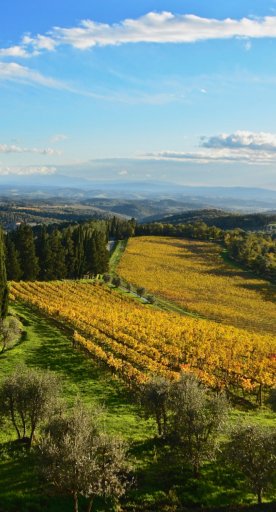A quick taste of Terricciola
White wine and other local wonders
Between Pontedera and Volterra stands the town of Terricciola that has a bit of a “split personality,” you could say. Its coat of arms even attests to this, with half a Florentine lily and half a Pisan cross showcasing its complicated history.
But there’s one local attribute that has never been contested: this is prime wine territory.
Wine may not be the most immediate association that travelers make with Pisa’s surrounding areas. But various towns throughout the Pisan hills, Terricciola included, have been producing (and consuming) it since Etruscan times. With the dawn of the Roman era, wine production remained a major source of income for Terricciola’s wealthiest.
Fast forward to the 18th century and Italian scientists Giovanni Targioni Tozzetti and Giovanni Mariti discussed Terricciola’s high quality of wine—along with its key economic role—in their detailed Valdera and Pisan hills travelogues.

Terricciola wine producers are part of the Strada del Vino delle Colline Pisane association, a wine route incorporating the inner Valdera and Valdarno, up to the Val di Cecina, and lined with the arbiters of the area’s top products: wine, but also extra virgin olive oil, truffles and pecorino cheese.
One of the main products of the area is the famous Chianti wine DOCG, made mainly from Sangiovese grapes, but the true must-try wine in Terricciola and nearby towns is Bianco Pisano di San Torpè DOC, a dry, delicate variety made primarily with Trebbiano Toscano (from 75-100%). A smaller percentage of other white grapes, such as Chardonnay and Vermentino, may be used. The taste is breezy and balanced, but the story behind its name is far less so: “San Torpè” derives from a Roman courtier to Emperor Nero called “Terpezio” who was beheaded and abandoned on a boat in Pisa in 68 C.E. upon converting to Christianity.
As for the less gritty details, Bianco Pisano di San Torpè DOC is gorgeous in a glass, usually tinted a straw-yellow hue. Meant to be enjoyed young, it tastes best paired with fresh (or even raw) fish. In colder temperatures, try it with a belly-warming, savory seafood-based stew.
We’d be remiss not to give you some options for your sweet tooth fix, too. Top off a long dinner in a local trattoria with Vin Santo Occhio di Pernice (literally “Holy Wine of the Eye of the Partridge—how’s that for a mouthful?) Distinguishing this dessert wine from similar items is its composition of minimum 50% Sangiovese grape, its intense, sweet-hot taste and its velvety, pinkish hue. Much of it is produced here in Terricciola, but turn to other Tuscan towns when deciding which cookies to dunk in it—biscotti di Prato make a solid choice.

Terricciola’s wines are center-stage year round, but the mid- and late-summer months bring an extra dose of grape-focused fun.
The Notte Bianca del Vino is a popular town-wide ritual and now a fixture on the local summer calendar for the first Saturday in July. Given the Italy-wide phenomenon of sporadic, all-night, city-wide parties known as “Notti Bianche” or “White Nights,” the name of Terricciola’s event conveys a dual meaning.
Around August 10, count on area wineries opening up their cellars for guided visits and tastings during the Calici di Stelle weekend and the Perseids meteor shower. Or save your energy for September: on the last weekend of the month, locals raise a glass to the new vintage with the Festa dell’Uva e del Vino, highlighting the harvest.




















































